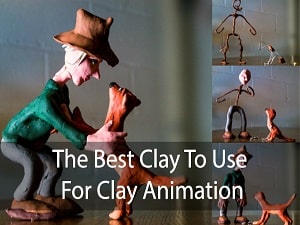
The Best Clay to Use for Clay Animation
The Best Clay to Use for Best Clay Animation
One way to jump into animation instantly without great expenditure is to use stop motion technique to animate clay or objects. Clay animation is particularly compelling as it lends itself perfectly to the amorphous transformations offered by drawn animation. Puppets, by comparison, are fixed in space and don’t allow for the squashing and stretching except replacement animation is used. The Best Clay to Use for Best Clay Animation is important.
The first thing is to get a capture system, such as Stop Motion Pro software, that will allow you to animate using cameras such as a video camera, a webcam, or a digital still camera. Once you have to choose the right kind of clay that can lend itself to animation. You should use Best Clay for Best Clay Animation.
Many students begin experimenting with classic water-based ceramic clay. This material is an age-old classic substance that has served the art world well for hundreds of years. While the clay can be animated, you find that you only have a short window of time to work with it as it quickly starts drying out in the air and lights. As the drying process proceeds, cracks appear, and the clay will need to be moistened to keep it malleable. The clay is muddy and messy. As the clay dries, it becomes dusty too. Ceramic clay doesn’t lend itself to color as it only comes in gray or brown and is a poor choice for animation.
Best Clay to Use for Clay Animation
The best clay to use for clay animation is Plastilina clay. It comes in a wide range of colors and is a formulation of clay and wax. The clay does not weep oil, as it is wax based. If one uses, a double boiler various colors of clay can be melted and blended to obtain a broad pallet to work with. This clay was used by Will Vinton when his studio executed his trademarked “Claymation” process for his films. This clay is readily available from hobby, toy, and art stores.
Another clay that can lend itself to the animation is Polymer clay such as Sculpey. Instead of ceramic mud the clay is made of plastic and is pliable for many months. It comes in many different colors that can be blended and animates well. This clay has the added feature of being able to be hardened in a home oven when baked in a temperature of 275 degrees Fahrenheit. The Polymer clay is more expensive than wax clay and can become a consideration.
The use of both Plastilina and Polymer clay can be an ideal choice for the animation as parts of the character you don’t need to distort such as eyeballs or teeth can be made of hardened Polymer clay and added to the wax clay to allow for a wide range of animation possibilities.
Kshitij Vivaan offers career courses in Animation, VFX, graphics, web designing & gaming for students from different cities of Gujarat such as Udaipur, Dungarpur and Jalore. KSHITIJ VIVAN helps these students get the best job placements according to their skills and talents to get the best start to their Professional Careers.



